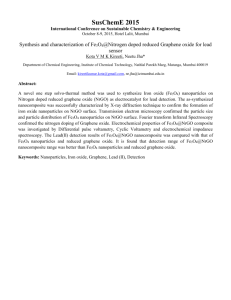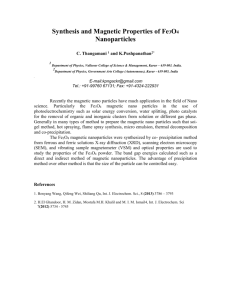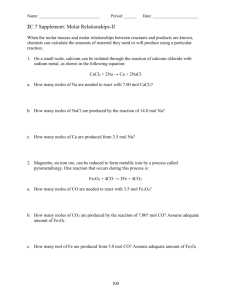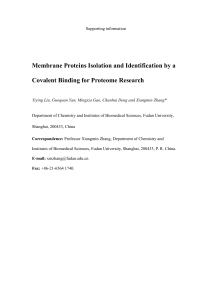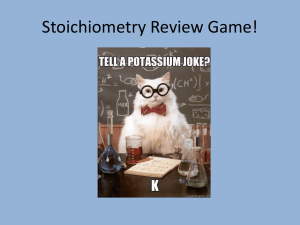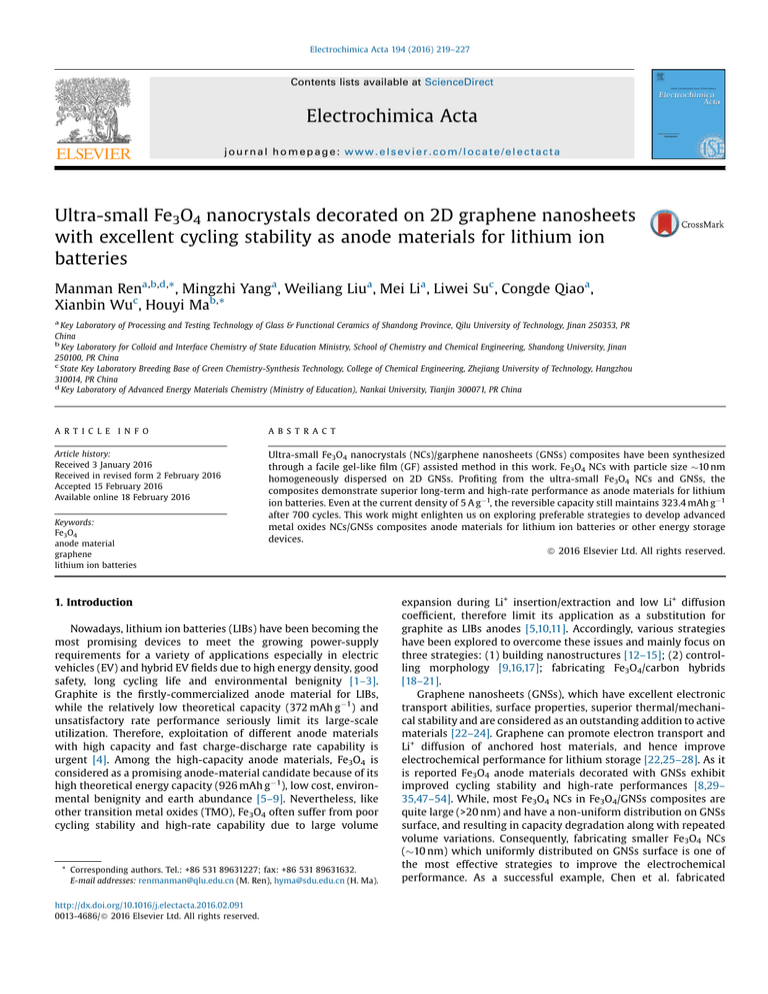
Electrochimica Acta 194 (2016) 219–227
Contents lists available at ScienceDirect
Electrochimica Acta
journal homepage: www.elsevier.com/locate/electacta
Ultra-small Fe3O4 nanocrystals decorated on 2D graphene nanosheets
with excellent cycling stability as anode materials for lithium ion
batteries
Manman Rena,b,d,* , Mingzhi Yanga , Weiliang Liua , Mei Lia , Liwei Suc , Congde Qiaoa ,
Xianbin Wuc, Houyi Mab,*
a
Key Laboratory of Processing and Testing Technology of Glass & Functional Ceramics of Shandong Province, Qilu University of Technology, Jinan 250353, PR
China
b
Key Laboratory for Colloid and Interface Chemistry of State Education Ministry, School of Chemistry and Chemical Engineering, Shandong University, Jinan
250100, PR China
c
State Key Laboratory Breeding Base of Green Chemistry-Synthesis Technology, College of Chemical Engineering, Zhejiang University of Technology, Hangzhou
310014, PR China
d
Key Laboratory of Advanced Energy Materials Chemistry (Ministry of Education), Nankai University, Tianjin 300071, PR China
A R T I C L E I N F O
A B S T R A C T
Article history:
Received 3 January 2016
Received in revised form 2 February 2016
Accepted 15 February 2016
Available online 18 February 2016
Ultra-small Fe3O4 nanocrystals (NCs)/garphene nanosheets (GNSs) composites have been synthesized
through a facile gel-like film (GF) assisted method in this work. Fe3O4 NCs with particle size 10 nm
homogeneously dispersed on 2D GNSs. Profiting from the ultra-small Fe3O4 NCs and GNSs, the
composites demonstrate superior long-term and high-rate performance as anode materials for lithium
ion batteries. Even at the current density of 5 A g 1, the reversible capacity still maintains 323.4 mAh g 1
after 700 cycles. This work might enlighten us on exploring preferable strategies to develop advanced
metal oxides NCs/GNSs composites anode materials for lithium ion batteries or other energy storage
devices.
ã 2016 Elsevier Ltd. All rights reserved.
Keywords:
Fe3O4
anode material
graphene
lithium ion batteries
1. Introduction
Nowadays, lithium ion batteries (LIBs) have been becoming the
most promising devices to meet the growing power-supply
requirements for a variety of applications especially in electric
vehicles (EV) and hybrid EV fields due to high energy density, good
safety, long cycling life and environmental benignity [1–3].
Graphite is the firstly-commercialized anode material for LIBs,
while the relatively low theoretical capacity (372 mAh g 1) and
unsatisfactory rate performance seriously limit its large-scale
utilization. Therefore, exploitation of different anode materials
with high capacity and fast charge-discharge rate capability is
urgent [4]. Among the high-capacity anode materials, Fe3O4 is
considered as a promising anode-material candidate because of its
high theoretical energy capacity (926 mAh g 1), low cost, environmental benignity and earth abundance [5–9]. Nevertheless, like
other transition metal oxides (TMO), Fe3O4 often suffer from poor
cycling stability and high-rate capability due to large volume
* Corresponding authors. Tel.: +86 531 89631227; fax: +86 531 89631632.
E-mail addresses: renmanman@qlu.edu.cn (M. Ren), hyma@sdu.edu.cn (H. Ma).
http://dx.doi.org/10.1016/j.electacta.2016.02.091
0013-4686/ ã 2016 Elsevier Ltd. All rights reserved.
expansion during Li+ insertion/extraction and low Li+ diffusion
coefficient, therefore limit its application as a substitution for
graphite as LIBs anodes [5,10,11]. Accordingly, various strategies
have been explored to overcome these issues and mainly focus on
three strategies: (1) building nanostructures [12–15]; (2) controlling morphology [9,16,17]; fabricating Fe3O4/carbon hybrids
[18–21].
Graphene nanosheets (GNSs), which have excellent electronic
transport abilities, surface properties, superior thermal/mechanical stability and are considered as an outstanding addition to active
materials [22–24]. Graphene can promote electron transport and
Li+ diffusion of anchored host materials, and hence improve
electrochemical performance for lithium storage [22,25–28]. As it
is reported Fe3O4 anode materials decorated with GNSs exhibit
improved cycling stability and high-rate performances [8,29–
35,47–54]. While, most Fe3O4 NCs in Fe3O4/GNSs composites are
quite large (>20 nm) and have a non-uniform distribution on GNSs
surface, and resulting in capacity degradation along with repeated
volume variations. Consequently, fabricating smaller Fe3O4 NCs
(10 nm) which uniformly distributed on GNSs surface is one of
the most effective strategies to improve the electrochemical
performance. As a successful example, Chen et al. fabricated
220
M. Ren et al. / Electrochimica Acta 194 (2016) 219–227
ultra-small Fe3O4 (5 nm)/GNS composites through a hydrothemal
method, and the composites demonstrated a reversible capacity of
437 mAh g 1 at the current density of 1800 mA g 1 after 1200 cycles
[35]. However, to the best of our knowledge, it still remains
challenging to produce Fe3O4 NCs/GNSs composites with low cost
and easy operation at the same time.
In the present work, Fe3O4 NCs/GNSs composites were prepared
through a simple gel-like film (GF) assisted solvothermal method.
This route is facile, efficient and easy operation. Herein, millions of
Fe3O4 NCs with the size about 10 nm were homogeneously
dispersed on GNSs surface, meanwhile, the composites delivered
excellently cycling stability and high-rate performances. When
tested at the current density of 100 mA g 1, the reversible capacity
after 180 cycles was 994.8 mAh g 1, still higher than the theoretical
value of Fe3O4. Even at a higher current density of 5 A g 1, the
reversible capacity still maintained 323.4 mAh g 1 after 700 cycles.
This work might enlighten us on exploring preferable strategies to
develop advanced transition metal oxides anode materials for LIBs
or other energy storage devices.
2.2. Materials Characterization
The morphologies and microstructures were investigated using
a ZEISS SUPRATM 55 scanning electron microscope (SEM) and a
Tecnai G2F30 transmission electron microscope (TEM). Highresolution TEM (HRTEM) was studied by using Tecnai G2F30 STwin operated at 300 kV. X-ray diffraction (XRD) patterns were
recorded by using SHMADZU XRD-6100AS with Cu Ka radiation
(l=1.5418 Å). Thermogravimetric analysis (TGA) was performed on
Perkin-Elmer, TG7, under N2 flow with heating rate of 1 C min 1.
Raman spectra were obtained using a Renishaw InVia micro Raman
system with an excitation wavelength of 532 nm. Nitrogen
adsorption isotherms and BET surface area were measured at
77 K with a Micromeritcs Gemini V2380 analyzer (USA). Highangle annular dark-field scanning TEM (HAADF-STEM), and energy
dispersive X-ray spectroscopy (EDX) were also measured at Tecnai
G2F30 S-Twin (operated at 300 kV) and FEI Tecnai G2F-20 fieldemission gun transmission electron microscope.
2.3. Electrochemical Measurements
2. Experimental
2.1. Materials Synthesis
All chemicals were of analytic grade and used without any
purification. Graphene oxide (GO) were prepared from natural
graphite flakes through a modified Hummers method [36,37].
Fe3O4 NCs/GNS composites were prepared through a GF assisted
solvothermal route [25]. In a typical synthesis, Fe(NO3)39H2O
(2.02 g) and GO (0.15 g) were dissolved in 75 mL ethylene glycol
under sonication for 3 h, and then sealed in a 100 mL polytetrafluorethylene (Teflon)-lined autoclave. After solvothermal treatment at 150 C for 2 h, the autoclave was naturally cooled to room
temperature. The precursor was collected by centrifugation,
washed with ethanol and dried by freezing drying, followed by
annealing at 500 C for 2 h in Ar to generate Fe3O4 NCs/GNSs. Pure
Fe3O4 was prepared under the same conditions except the GO.
Electrochemical performances of the samples were evaluated in
2032 coin-type cells. The working electrodes consisted of active
materials, acetylene black (AB), and polyvinylidene fluoride (PVDF)
with a weight ratio of 70:20:10 and pasted on pure copper foil. The
as-prepared electrodes were dried at 110 C for 10 h in vacuum.
Each electrode was approximately 1.0 mg with the diameter of
14 mm. Lithium metal was used as the counter and reference
electrode. The electrolyte consist of a solution of 1 M LiPF6
dissolved in a 1:1:1 mixture solution of ethylene carbonate (EC),
dimethyl carbonate (DMC), and ethylene methyl carbonate (EMC).
Test cells were assembled in an argon-filled dry glove box.
Galvanostatic charge/discharge tests were performed on a LAHE
battery test system at various current densities in the potential
range of 0.01–3.00 V (vs. Li/Li+) at room temperature. Cyclic
voltammograms (CV) and electrochemical impedance spectroscopy (EIS) were conducted on a CHI660E electrochemical workstation. The CV curves were recorded in 0.01–3.00 V at a scanning rate
of 0.1 mV s 1. EIS were tested at the frequency ranging from 10 kHz
Fig. 1. SEM images of pure Fe3O4 (A and B), and Fe3O4 NCs/GNSs composites (C and D).
ID
183116
Title
Ultra-smallFe3O4nanocrystalsdecoratedon2Dgraphenenanosheetswithexcellentcyclingstabilityas
anodematerialsforlithiumionbatteries
http://fulltext.study/article/183116
http://FullText.Study
Pages
9

